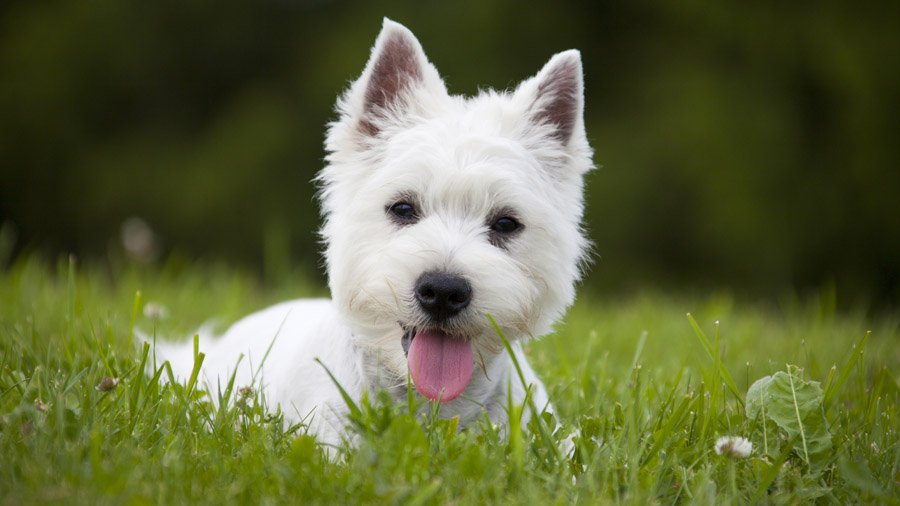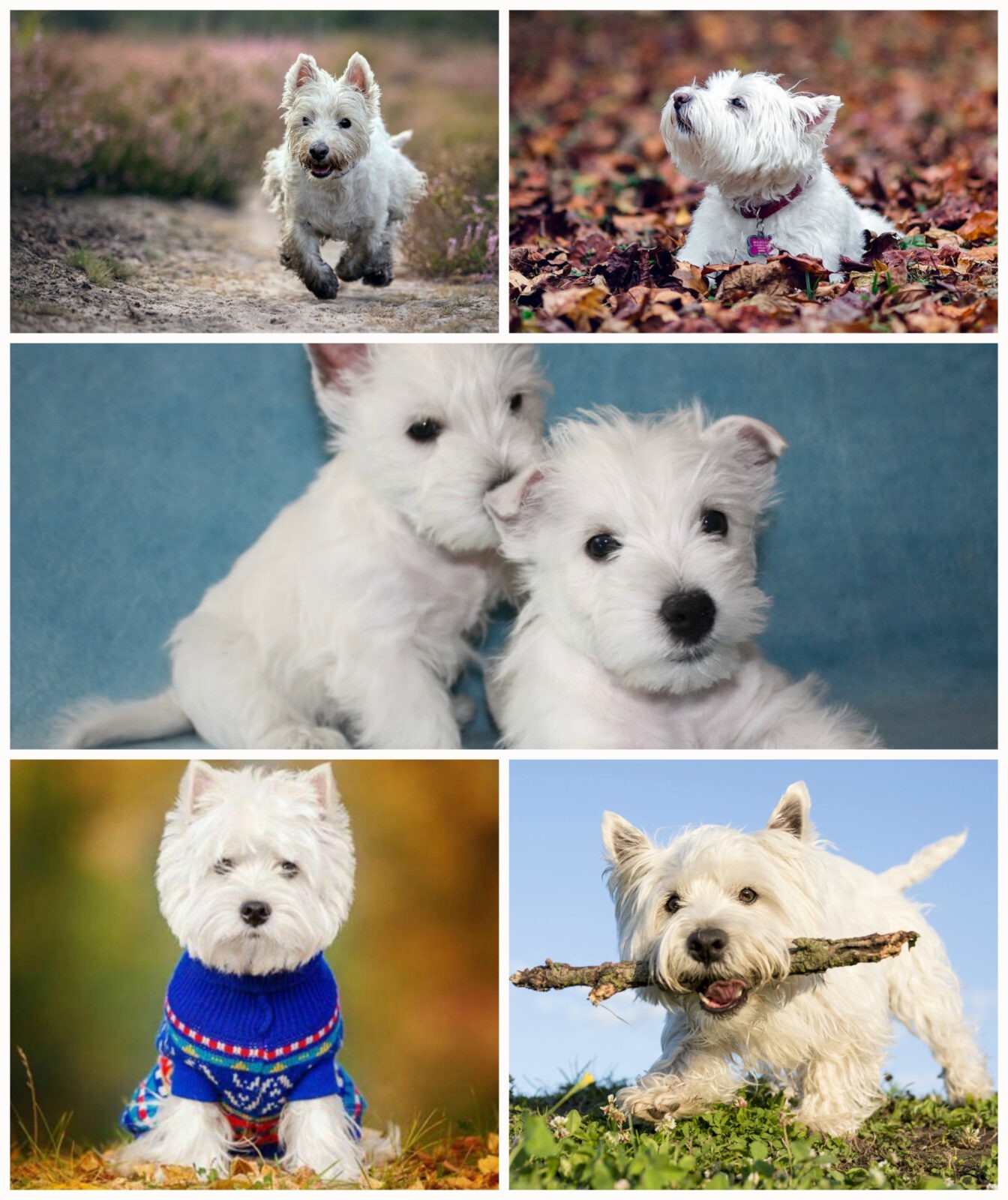
Brief description of the breed
On the territory of the British Isles, these dogs have proven themselves to be excellent catchers of foxes, otters, badgers, rabbits, small rodents, operating underground without hearing the owner. But in Russia they are purchased to serve a person at home due to their small size (weight about 8-10 kg, height at the withers - 25-30 cm) and complaisance, if the owner from the very acquaintance with the puppy managed to establish the correct connection (where the dog always obeys the owner). Also, Russian representatives of the breed successfully participate in competitive events, but they are rarely used in the capture of a burrowing animal in our country.
Distinctive external features of these Scottish dogs - white coat without any inclusions and smart dark-colored eyes. The constitution of such terriers is strong, compact and rather muscular. The cranium is convex, the transition from the forehead to the muzzle is pronounced, the superciliary arches are protruding and noticeable. The muzzle tapers towards the nose (black), the eyes are widely spaced relative to each other, the protruding forehead of the dog makes the eyes deep set. The ears of the West Highland White Terrier are small and triangular in shape. The neck, whose diameter at the base is rather large, muscular and strong. The chest is deep, the ribs are smoothed at the edges. The back is straight, widened in the lumbar region, muscular. The tail is high-set, of medium (or even small) length, carried perpendicular to the body of the dog, not curled over the back. The limbs are strong (especially muscular rear) and powerful, not long, proportional to the body of the dog. The coat is hard, straight and dense, the undercoat is soft and short. They live about 12-15 years.
basic information
| Breed name: | West Highland White Terrier |
| Country of origin: | Scotland |
| The time of the birth of the breed: | 19th century |
| Type of: | terriers |
| The weight: | 8 – 10 kg |
| Height (height at the withers): | 25 - 30 cm |
| Life Expectancy: | 12 - 15 years old |
|
ICF classification:
|
Group 3, Section 2, Number 085 |
| Puppies price: | 200 – 1870 $ |
| Most popular nicknames: | List of names for the West Highland White Terrier |
Assessment of breed characteristics
| Adaptability
(a definition meaning how easily a dog can adapt to changes in life) |
🐶🐶🐶🐶 |
| Shedding level
(Level and frequency of hair loss in the animal) |
🐶 |
| Tenderness level
(The level and amount of tenderness and affection that the dog gives in return for attention to itself) |
🐶🐶🐶🐶 |
| Exercise needs
(Dog's daytime activity level) |
🐶🐶🐶🐶 |
| Social need
(The required number of contacts of the dog with other animals, as well as people) |
🐶🐶🐶🐶 |
| Apartment content
(A factor that determines the level of noise and other inconveniences that a dog can deliver to owners in relation to the size of the apartment to the size of the dog) |
🐶🐶🐶 |
| Grooming
(The number of bathing, brushing, and the number of professional grooming sessions required for the dog) |
🐶🐶🐶🐶 |
| Friendliness in an unfamiliar environment
(Features of the behavior of a dog in a society with strangers or in an unfamiliar environment) |
🐶🐶🐶 |
| Tendency to bark
(Tendency to bark and its frequency and volume) |
🐶🐶🐶🐶🐶 |
| Health issues
(Potential health status of the dog) |
🐶🐶🐶🐶🐶 |
| Territoriality
(The dog's tendency to protect his home, yard, or even his owner's car) |
🐶🐶🐶🐶🐶 |
| Friendliness to cats
(The tendency towards tolerance for cats and decreased manifestation of hunting instincts) |
🐶🐶🐶 |
| Intelligence
(The ability of the dog to think and solve emerging difficulties (not to be confused with learning!) |
🐶🐶🐶🐶 |
| Education and training
(The level of difficulty in training the dog to perform certain actions) |
🐶🐶🐶🐶 |
| Friendliness to children
(A factor that determines how friendly a dog is to children, whether he likes to play with them and tolerate some childish pranks) |
🐶🐶🐶🐶 |
| Game activity
(The concept is determined by its very name, and, as a rule, is found in almost all dogs) |
🐶🐶🐶🐶 |
| Observation
(The ability of a dog to detect the presence of a stranger on its territory) |
🐶🐶🐶🐶🐶 |
| Friendliness to other dogs
(The tendency of the dog to find common language with his other relatives) |
🐶🐶🐶🐶 |
Photos of the West Highland White Terrier:
Origin story west highland white terrier
Character west highland white terrier
Maintenance and care
These little terriers can be kept in small apartments, and in houses with a large living area. The dog’s place should be located away from the draft, it should be equipped not only with a bed, but also with toys (so that the dog can spend his energy when the owner cannot entertain him). Also, a bowl of clean drinking water should always be with the bed. In some cases, for West Highland White Terriers, they are placed near a bed and a tray with toilet filler.
A prerequisite for keeping a West Highland White Terrier is fairly long and active walks. If the owner has his own land, a dog of this breed will be happy to spend time in the yard, play, run, just breathe fresh air. But even with such a pastime, you should not replace full-fledged outings (to the training ground) and trips out of town with walks around the perimeter of the yard, since communication with other dogs, the contemplation of people, cars, the perception of the sounds of the city is extremely important for the socialization of the animal.
Caring for the coat of a Vesti Terrier will require some time (and often money). And it's not at all in the snow-white color of the fur coat - these rough-haired dogs get dirty no more than other four-legged ones (in addition, coarse hairs can repel dirt). Hair care involves daily (or at least every other day) combing with a metal brush, during which not only dead hairs are removed, but also dirt is cleaned, and the process of blood circulation of the animal improves. In addition to home care, the virtually non-shedding West Highland Terriers (like their other wire-haired counterparts) -fox terriers, Cairn Terriers, Welsh Terriers, etc.) need the services of trimming masters (trimming - removal of old and thinned hairs by plucking). The procedure should be carried out at least 2 times a year. Sometimes non-show dogs are trimmed at home or in a grooming salon (where they can offer a hygienic or model haircut, as well as a number of services: nail care, washing, cleaning of ears, teeth and paraanal glands, cosmetic procedures, etc.). Insufficient attention to hair care can lead not only to the formation of tangles - parasites can start in groomed wool. Also, cases of allergic and fungal diseases in wire-haired West Highland White Terriers are not uncommon. But bathing a non-show dog too often is not worth it, just wash the paws after walking, and arrange "bath" days as they get dirty, but not more than 3-4 times a year. By the way, dogs of this breed do not have a specific smell and are quite clean.
As food for the West Terrier, you can choose natural food or ready-made dry food (before buying a puppy, you should ask the breeder what kind of food your baby is used to). Benefits of prepared food - balance, low consumption, saving the owner's time. Negative side - high price of really good food. Feeding natural food (not to be confused with dishes designed for people) will require the owner not only time, but also certain knowledge in order to correctly calculate the calorie content, choose the right ingredients for preparing a dog dish, and also calculate the content of vitamins and nutrients. The composition of natural food should be dominated by high-quality meat (which is also not cheap at the present time).
Training and education of the West Highland White Terrier
The characteristic Scottish West Highland White Terrier should be brought up in an environment of love and reasonable severity. It is naive to believe that a puppy who is allowed any prank will grow up to be a well-mannered dog. From the first hours of the dog's stay in the house, the owner must establish proper contact with the animal, then the dog will trust the person, considering him the leader. Ill-mannered messages can commit a number of actions that are unpleasant and dangerous. - chasing other animals, picking up some food or objects on the street, digging up the owner's beds, and so on. A trained dog will not cause trouble either to the owner or to anyone else. As a compliment for good behavior, a dog can be rewarded with a treat and a kind word. As a punishment, you can influence with a stern voice, as well as ignore the dog, not responding to its calls to play. Don't hit an animal - this is not only insulting, but also separates the news from the owner, introduces distrust of the person.
Dogs of this breed have been trained for about six months - on their own or with the help of an instructor. In the process of learning, the dog will learn not only the main commands, but will also behave correctly outside the house. Probably the best option for training a West Highland Terrier when the process is led by the owner under the guidance of a specialist. But for this, from an early age, the puppy must trust the owner.
Health and disease of the West Highland White Terrier
Some interesting facts about West Highland White Terrier
- Literally, the name of the breed can be translated as "white burrowing dog from the west of the Highlands (the largest of the 32 regions of Scotland)".
- The snow-white coat, coupled with black pigmentation of the nose, lips, eyelids and fingertips, makes dogs of this breed look like small white bears. However, their nature may not be soft at all. When an animal gets excited, such qualities as courage, courage and fearlessness are revealed.
- In the filming of the famous French film "Asterix and Obelix" about the adventures of the Gauls, dogs of the West Highland White Terrier breed took part, playing roles along with the famous Gerard Depardieu.
- The price for a puppy of this breed of show class can be about 60,000-100,000 rubles, a breed class will cost from 30,000 to 60,000 rubles, and a pet puppy can be purchased for 20,000-30,000 rubles.
Nurseries and breeders
We borrowed material from the wonderful site of our partners DOGCATFAN.COM about cats and dogs, the author dogcatfan

